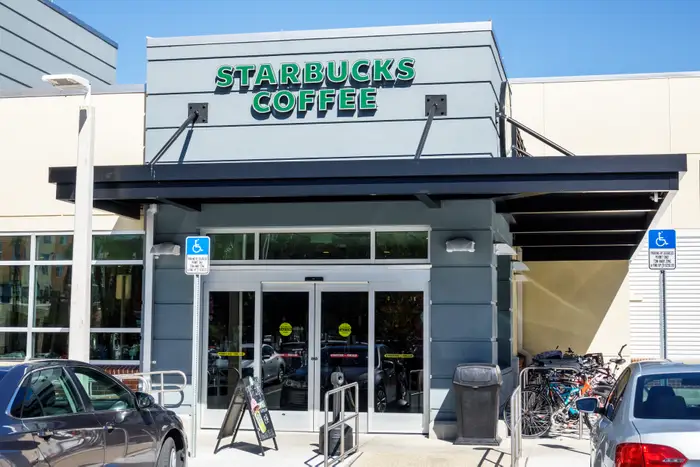With the installation of fast-charging stations at 100 Starbucks shops, Mercedes-Benz is launching a novel initiative to improve the infrastructure for EV charging across the country. In tackling range anxiety, a major barrier for EV owners, this program is a big step forward. One of the biggest obstacles for prospective electric vehicle purchasers has been range anxiety, or the fear that an EV may run out of battery power before arriving at a charging station. Mercedes-Benz hopes to alleviate this problem and provide EV drivers a practical answer by placing high-speed charging stations at well-known Starbucks locations.
The new charging stations, boasting 400 kW power capabilities, will enable compatible EVs to charge to about 80% capacity within approximately 30 minutes. This rapid charging technology represents a considerable advancement over older models and reflects ongoing improvements in battery and charging infrastructure. The strategic placement of these charging stations will include critical routes such as Interstate 5, a major highway running from Canada to Mexico. This route is significant for long-distance travel along the West Coast, and having reliable charging options on this route will greatly enhance the convenience and accessibility of long trips for EV owners.
The partnership between Mercedes-Benz and Starbucks is mutually beneficial. For Mercedes-Benz, it is an opportunity to expand the reach of its high-power charging network and address one of the major barriers to EV adoption. For Starbucks, it represents a chance to attract more customers to its stores. By providing a place where drivers can charge their EVs while enjoying a coffee or a snack, Starbucks hopes to drive additional foot traffic to its locations. This could lead to increased sales and enhanced customer engagement. Additionally, this initiative aligns with Starbucks’ broader sustainability goals, which include a commitment to reducing carbon emissions by 50% by 2030. The installation of these charging stations complements Starbucks’ efforts to promote environmentally friendly practices and support the transition to electric mobility.
The issue of range anxiety has been a significant factor in the slower adoption of electric vehicles. Early EV models had limited ranges, often only about 100 miles per charge under ideal conditions. However, advancements in battery technology have significantly increased this range, with many modern EVs capable of traveling several hundred miles on a single charge. Despite these improvements, inconsistent and insufficient charging infrastructure continues to be a major hurdle. A recent survey by McKinsey highlighted that 46% of US EV owners considered switching back to gasoline vehicles due to concerns about the availability of charging stations. By expanding the network of fast-charging stations to widely recognized and frequented locations, Mercedes-Benz and Starbucks aim to reduce this concern and encourage more people to consider electric vehicles as a viable alternative to traditional gasoline-powered cars.
The collaboration between Mercedes-Benz and Starbucks is part of a larger trend in the industry where EV manufacturers partner with various businesses to develop comprehensive charging networks. Mercedes-Benz has previously worked with companies like Buc-ee’s and Simon Property to establish high-power charging hubs across the US. The company’s strategy has focused on placing charging stations in areas with high concentrations of EV drivers and along major travel routes to address gaps in the existing infrastructure. The addition of Starbucks locations to this network expands the reach of these charging hubs and integrates EV charging into everyday activities.
While Starbucks will not be covering the installation costs of the charging stations, it will provide space at its stores for the chargers and related equipment. Each participating Starbucks location will have a minimum of four chargers, although the exact number may vary depending on the site. This arrangement allows Starbucks to support the development of EV infrastructure without incurring the costs of installation. The company is also exploring how customers interact with EV charging stations and considering further partnerships and expansions based on these insights.
In addition to the practical benefits for EV owners, this partnership also reflects broader industry trends towards sustainability and environmental responsibility. The expansion of EV charging infrastructure is crucial for supporting the growth of electric mobility and reducing dependence on fossil fuels. Mercedes-Benz’s $1 billion investment in developing a high-power charging network underscores its commitment to advancing EV technology and supporting the transition to cleaner transportation. Since opening its first high-power charging site in November, the company has established a dozen locations with 400 kW chargers and plans to expand its network to cover half of the US within the next 18 months.
When it comes to tackling the obstacles related to EV adoption, Mercedes-Benz and Starbucks’ partnership is a big step forward. The alliance hopes to lessen range anxiety and persuade more people to think about driving electric vehicles by placing fast-charging stations in familiar and convenient areas. In addition, it presents Starbucks with a chance to expand its clientele and improve its environmental initiatives. This program is a reflection of the growing understanding that a reliable and easily available infrastructure for charging electric vehicles is necessary to facilitate their wider adoption and accelerate the shift to a more environmentally friendly transportation system.
If you like the article please follow on THE UBJ.
